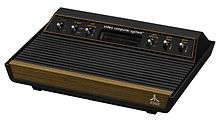Carla Meninsky
Carla Meninsky is former video game designer and programmer during the early years of the Atari VCS.[1] Along with Carol Shaw (creator of 3-D Tic-Tac-Toe and River Raid), Meninsky was one of two female engineers at Atari, Inc. to develop video game cartridges.[2] She later became an intellectual property lawyer.
Background
Meninsky's mother was a programmer and Carla learned programming in high school, but she switched from mathematics to neuropsychology and brain modelling at Stanford University. Given her artistic bent, Meninsky was particularly interested in vision and eventually veered back toward programming and a lifelong dream of creating animation tools.
She began her college career at Stanford studying math, but eventually switched to psychology because it sounded more exciting. She learned basic Fortran in high school from her mother, who was a programmer, and through this built an interest in computer animation.[3]
Atari, Inc.
Meninsky joined Atari after graduating from Stanford University with a degree in psychology.
Her first Atari 2600 game was Indy 500, co-written with Ed Riddle,[4] and released in 1977 as a launch title for the system. It's a simplified version of the Indy 800 Atari arcade game, and the only 2600 game to make use of the "driving controllers" that shipped with it. She also wrote the 1980 racing game Dodge 'Em (similar to the 1979 Head On coin-op from Sega), a 1981 port of Atari's Warlords, and the 2600 version of Star Raiders (originally designed by Doug Neubauer for the Atari 8-bit family).[3] She later worked on a port Tempest that was never released, but prototypes exist.[5]
Law practice
Meninsky worked for Electronic Arts (EA) and other game publishers and eventually started her own successful contract programming company. In the course of writing contracts and seeing intellectual property rights being ignored by some companies, she became interested in intellectual property law.[6]
Meninsky graduated from George Washington University Law School and now practices intellectual property law.[7] As an EPIC Public Interest Opportunities Program Fellow, Meninsky testified before the U.S. Senate in 2002.[8]
References
- ↑ Fulton, Steve (August 21, 2008). "Atari: The Golden Years — A History, 1978–1981". Gamasutra. Retrieved December 4, 2010.
- ↑ Crawford, Chris (2003). Chris Crawford on Game Design. New Riders Games. pp. 223, 437. ISBN 0-13-146099-4.
- 1 2 "Will Nicholes - Interview with Carla Meninsky (page 1)". willnicholes.com. Retrieved 2016-06-26.
- ↑ Hague, James. "The Giant List of Classic Game Programmers".
- ↑ Yarusso, Albert. "Programmers: Carla Meninsky". AtariAge. Retrieved December 3, 2010.
- ↑ Nicholes, Will. "Interview with Carla Meninsky". Retrieved 16 October 2012.
- ↑ Meninsky, Carla. "Computer Programs and Copyright: Using Technological Measures to Lock out Competition". Munich Intellectual Property Law Center. Retrieved 2011-03-27.
- ↑ Rotenberg, Marc; Meninsky, Carla. "EPIC Statement on Biometrics and Identify Theft". Electronic Privacy Information Center. Retrieved 2011-03-27.
Publications
Meninsky, Carla. "Locked Out: The New Hazards of Reverse Engineering". The John Marshall Journal of Computer & Information Law Vol. XXI Summer 2003 No. 4. Retrieved 2015-05-23.
